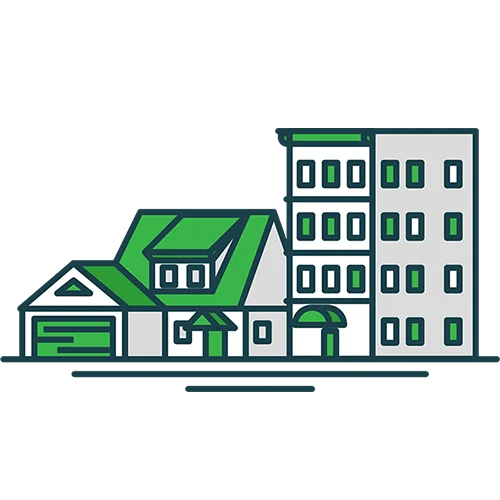Crucial Home Construction Types for Insurance Purposes
- Insurance 101
- /
- Crucial Home Construction Types for Insurance Purposes
When getting a home insurance quote, you’re usually asked what material your house is made from. The two most common options are masonry and frame. If you’re unfamiliar with these terms, don’t worry, you’re not alone.
Keep reading this breakdown of home construction types for insurance to find out:
- why providers want to know the type of building construction for insurance
- how you can tell what construction method was used for your home
- what the different materials can mean for your homeowners insurance rates
Home Construction Types for Insurance: Why It Matters
Home insurance companies need to assess the risk of covering your house before they offer you a policy. To do this, they consider a variety of factors to get the most insightful picture of your house and the potential damage it can sustain.
One of the insurer’s most important concerns is the material with which your home is built, as this can directly affect how your house can withstand certain natural disasters, like tornadoes and hurricanes, and other perils, like fires, which the insurance company is supposed to protect you from.
If your home is built from a material that is proven to handle strong winds and fires better, you’re likely to have a lower rate since your home is less at risk of sustaining damage.
When getting quotes, you may find the following options for home construction:
- Frame
- Masonry
- Masonry Veneer

We partner with the nation’s top homeowners insurance companies so you can get a custom policy at an affordable price.
Construction Type: Masonry vs. Frame
The two most common home types in residential construction are frame houses and masonry houses. For insurance purposes, frame homes will often be more expensive to get coverage for since they’re more combustible and more likely to deteriorate over time.
A frame house is usually made out of wood with drywall and insulation packed on and around it. Pieces of timber are made into a frame. This might be the classic image you think of when you picture a home being built.
A masonry home, on the other hand, is typically made from bricks, stones, or concrete blocks held together with mortar. As you might imagine, these homes are sturdier, although they may cost more to build.
Masonry construction is generally better for home insurance purposes. In addition to withstanding fire and wind damage better than the wood in frame houses, bricks or concrete blocks are largely impervious to termite damage.
Mathematically, when determining rates, carriers usually include building materials as a factor in the premium calculation. Although the exact percentage or number will vary by insurer, the frame construction number is usually higher than the masonry construction number, which causes the premium to increase when it is factored in.
Despite their sturdiness, you’re less likely to find new masonry houses being built. Frame houses are much more common today in the United States because they’re much more cost- and time-effective.
Wood is usually cheaper to purchase and cheaper to transport than bricks. It’s easier and quicker to erect a frame house, and the planning for insulation, electrical wiring, and plumbing is more straightforward. Frame houses are often also easier to modify later on.
Masonry and Brick Veneers and Insurance
Just because bricks are visible on the outside of your home doesn’t mean you live in an entirely brick home, either. Instead, many “brick” homes today are often built with wooden frames and just a brick veneer on the exterior. The bricks don’t structurally support the home. So, houses with brick veneers aren’t considered masonry houses.
Brick veneers are mainly aesthetic and typically only one layer thick. A true brick-built masonry home has at least two layers of brick that make up the entirety of the walls.
Nevertheless, since bricks are less flammable than wood, you may be rewarded for having a brick veneer on your home when it comes to insurance premiums. It’s possible that the more brick veneer that you have on the outside of your frame home, the lower your rate may be. But, your savings won’t be as significant as if your house was wholly made of brick.
How Do I Know If My Home Is Wood Frame Construction vs. Concrete Block?
If you can’t tell from the exterior, a good way to tell whether your house is masonry or frame lies within the walls. Frame homes have wooden studs running vertically through the walls with space for insulation in between them. Masonry homes won’t have wooden studs. They’d have blocks of concrete, tile, or stone between the exterior material of the wall and the drywall.

We partner with the nation’s top homeowners insurance companies so you can get a custom policy at an affordable price.
Joisted Masonry vs. Frame Definition
Another possible option for the type of building construction for insurance is joisted masonry. With joisted masonry construction type, the exterior load-bearing walls are made of masonry materials (brick, concrete, stone, or tile), while the floor and roof are still made of wood.
In a frame house, the walls, floors, and roof are made of wood. Wood supports the whole structure. In a masonry house, the masonry (the bricks or concrete) is load-bearing. In some commercial properties, you may find joisted masonry construction.
Joisted masonry makes a home sturdier than a frame home, but not as fire-resistant as a complete masonry home. As a result, the insurance premium on a joisted masonry building may fall between frame and masonry ones. It may be less expensive to insure than a frame structure, but more costly than a masonry building.
Are Brick Homes Cheaper to Insure?
Because brick and masonry homes are more resistant to fire and wind damage than frame houses, brick houses tend to have lower premiums. Although a lot of factors can affect rates, a provider may charge a lower premium for a brick home than for a similar-sized frame home in the same location.
However, the increased cost of building with brick may mean that you need a higher level of coverage for your home. You should cover your home for its replacement cost, meaning the amount you’d need to rebuild it if it was destroyed entirely. The brick vs. wood house cost may be higher on brick homes since the materials and labor cost more.
It’s also important to know that there’s one major exception to insurance savings for brick homes: earthquake-prone areas. Since bricks (or concrete) and mortar are heavier and more rigid than wood, masonry homes can suffer greater damage from earthquakes than a more flexible, wooden-framed home.
Mortar can crack and the bricks can separate. Also, the weight of the bricks puts more pressure on the foundation overall, which can cause problematic damage.
You may end up paying a higher insurance rate if you own a brick home in an earthquake-prone area than for a frame home.
What to Know About the Architectural Style of Home for Insurance Purposes
If a quote process doesn’t ask about your home construction, it may ask about the architectural style. Some common architectural styles include ranch, colonial, farmhouse, modern, and Cape Cod. The architectural style of your home likely won’t directly impact your premiums, but the elements that go along with it will.
For instance, having high-end installations and unique features will raise your replacement cost, and thus your premiums, since it would raise the reconstruction cost of your house if it were to suffer damage. As a result, some architectural styles that lend to such features, like Victorian or Tudor.
Due to their durability, metal roofs often produce lower rates than other roof types. Additionally, adding wind-resistant features to home construction, like hurricane windows, will reduce premiums.
Also, historic homes typically have higher premiums due to outdated features and construction. This has to do more with their age than building styles, but some styles known to be older are more likely to fall under this category.
In some cases, they may not qualify for traditional homeowners insurance, formally known as an HO-3 policy, and most instead receive coverage through an HO-8 policy, which is slightly less comprehensive.
You may also look inside the walls if you’re not sure whether your home is a brick veneer or a full-brick house, too. Since brick veneer homes are ultimately frame homes, there won’t be any brick inside the walls of a brick veneer home other than the backside of the exterior veneer. The walls would be hollow, or at least more hollow than a true brick home. There would be a frame with space in between the studs.
A true brick home would have solid, brick-load-bearing walls. You might be able to tell by just knocking on the wall from the inside and hearing whether it’s solid or hollow. Or, you could drill into it and see whether you pierce layers of brick or not.
If you’re not sure what type of home construction you have when getting a quote, the insurance company may by default place you in a frame home since they’re generally more popular. The provider has to err on the side of caution and may assume your house is more inherently risky than it actually is. To get the best and most accurate quotes, you should know what materials your house is built with.

We partner with the nation's top home insurance companies so you can get an excellent policy at an affordable price.
The editorial content on Clovered’s website is meant to be informational material and should not be considered legal advice.
Similar Articles
 3 Min Read
3 Min Read
 6 Min Read
6 Min Read
 5 Min Read
5 Min Read

